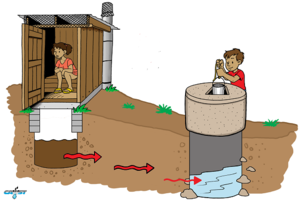| Waterborne diseases | |
|---|---|
 | |
| Waterborne diseases can be spread via groundwater which is contaminated with fecal pathogens from pit latrines. | |
| Specialty | Infectious disease |
Waterborne diseases are conditions (meaning adverse effects on human health, such as death, disability, illness or disorders)[1]: 47 caused by pathogenic micro-organisms that are transmitted by water. These diseases can be spread while bathing, washing, drinking water, or by eating food exposed to contaminated water.[2] They are a pressing issue in rural areas amongst developing countries all over the world. While diarrhea and vomiting are the most commonly reported symptoms of waterborne illness, other symptoms can include skin, ear, respiratory, or eye problems.[3] Lack of clean water supply, sanitation and hygiene (WASH) are major causes for the spread of waterborne diseases in a community. Therefore, reliable access to clean drinking water and sanitation is the main method to prevent waterborne diseases.[4]
Microorganisms causing diseases that characteristically are waterborne prominently include protozoa and bacteria, many of which are intestinal parasites, or invade the tissues or circulatory system through walls of the digestive tract. Various other waterborne diseases are caused by viruses.
Yet other important classes of waterborne diseases are caused by metazoan parasites. Typical examples include certain Nematoda, that is to say "roundworms". As an example of waterborne Nematode infections, one important waterborne nematode disease is Dracunculiasis. It is acquired by swallowing water in which certain copepoda occur that act as vectors for the Nematoda. Anyone swallowing a copepod that happens to be infected with Nematode larvae in the genus Dracunculus, becomes liable to infection. The larvae cause guinea worm disease.[5]
Another class of waterborne metazoan pathogens are certain members of the Schistosomatidae, a family of blood flukes. They usually infect people that make skin contact with the water.[5] Blood flukes are pathogens that cause Schistosomiasis of various forms, more or less seriously affecting hundreds of millions of people worldwide.[6]
- ^ Von Sperling, M. (2015). "Wastewater Characteristics, Treatment and Disposal". Water Intelligence Online. 6: 9781780402086. doi:10.2166/9781780402086. ISSN 1476-1777.
- ^ "Water-Borne Diseases". News-Medical.net. 2018-05-14. Retrieved 2021-10-27.
- ^ Guidelines for drinking-water quality. World Health Organization (Fourth edition incorporating the first addendum ed.). Geneva. 2017. ISBN 9789241549950. OCLC 975491910.
{{cite book}}: CS1 maint: location missing publisher (link) CS1 maint: others (link) - ^ Cite error: The named reference
WHOwas invoked but never defined (see the help page). - ^ a b Janovy J, Schmidt GD, Roberts LS (1996). Gerald D. Schmidt & Larry S. Roberts' Foundations of parasitology. Dubuque, Iowa: Wm. C. Brown. ISBN 978-0-697-26071-0.
- ^ Centers for Disease Control and Prevention: National Center for Emerging and Zoonotic Infectious Diseases (NCEZID), Division of Global Migration and Quarantine (DGMQ) (2011). "Chapter 3". In Brunette GW (ed.). CDC Health Information for International Travel 2012. The Yellow Book. Oxford University Press. ISBN 978-0-19-976901-8.